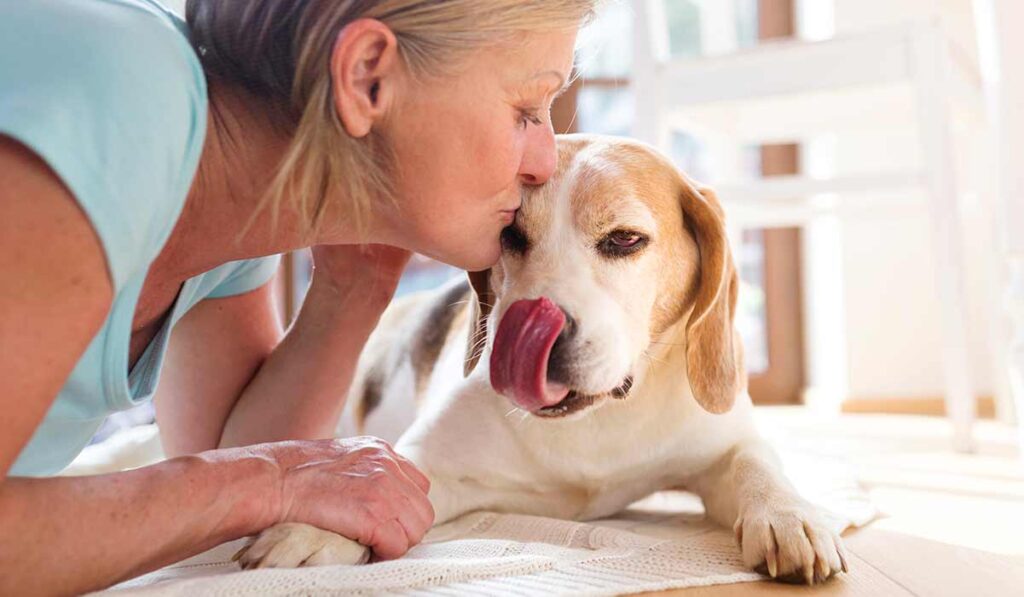
Dog strokes happen when the blood flow to the brain gets blocked or your pet suffers from hemorrhage causing temporary or permanent brain damage. They can happen out of the blue without any warning signs.
When a dog has a stroke, he doesn’t show signs such as paralysis like humans do. While the symptoms are subtle, a stroke can cause significant damage if not detected early. That’s why it’s important to be able to identify dog stroke symptoms so that you can give them the help, attention, and treatments they need to get back to normal.
Most Frequent Dog Stroke Symptoms
Below are the following symptoms most often observed when a dog experiences a stroke:
- Head tilt
- Loss of balance, moving in circles, and falling over
- Eating out of one side of the food bowl
- Turning the wrong way when called
- Confusion
- Depression
- Loss of sight or blindness
- Lethargy
- An abrupt or drastic change in behavior
- Loss of bowel or bladder control
- Seizure
However, dog stroke symptoms will also vary by type of stroke. Let’s now have a quick look at the most common symptoms by type of stroke.
Dog Stroke Symptoms by Type of Stroke
Dog stroke symptoms will depend on the type of stroke that your dog may be experiencing. We have listed below the most frequent canine strokes along with a list of commonly observed symptoms for each:
| Type of Stroke | Symptoms |
|---|---|
| Ischemic stroke Ischemic strokes are the most common type of strokes in dogs. This stroke is a result of loss of oxygen to a portion of the brain after the blockage of an artery. | – Loss of balance. – Head tilt. – Pacing, circling or turning the wrong way when called. – Abnormal eye movements or facial expressions. – Impaired vision. – Loss of control over bladder and bowels. – Vomiting. – Collapse, loss of consciousness. |
| Hemorrhagic brain stroke Hemorrhagic stroke occurs when a vessel in the brain ruptures and bleeding occurs. This leaking of blood out of the vessel and into the brain tissues results in increased pressure and swelling in the brain. These events often lead to a disruption of oxygen to the brain tissues. | – Loss of balance – Head tilt – Pacing, circling or turning the wrong way when called – Abnormal eye movements or facial expressions – Impaired vision – Loss of control over bladder and bowels – Vomiting – Collapse, loss of consciousness. |
| Spinal stroke (Fibrocartilaginous embolism – FCE) A piece of fibrocartilage from a nearby intervertebral disk dislodges and enters the bloodstream. This fibrocartilage piece flows down the bloodstream until it lodges in a blood vessel that supplies the spinal cord. | – Lameness or limping in one leg or both legs on one side. – Partial or complete paralysis of one or more limbs on one side. – Typically these dogs are not in pain. |
| Heat stroke Despite the name, heat strokes are not technically strokes: heat stroke occurs when the dog’s body overheats, commonly due to over-exertion or increased environmental temperatures. | – Collapse – Excessive panting – Bright red tongue and gums – Confusion – Increased pulse and heart rate – Thick saliva – Drooling – Vomiting – Difficulty breathing – Coma or Death |
Important Facts about Dog Strokes
- Recovery from a stroke depends on the stroke severity. Many dogs will start showing improvements within a few weeks.
- Many dogs do recover from strokes and suffer few lasting effects. It is important, however, to get a definitive diagnosis and rule out underlying conditions.
- If there is not a definitive diagnosis of an underlying condition, it is estimated that 50% of dogs will have another stroke episode so they should still be closely monitored.
- Dog strokes can be diagnosed using CT or MRI.
- Further testing may be required to find the underlying cause that has led to the stroke (for example, blood work or ultrasounds may be needed).
The Importance of Taking Quick Action If You Notice Stroke Symptoms
While symptoms of canine strokes can be subtle, a stroke can cause significant damage if not detected and treated early. That’s why it’s important to be able to identify dog stroke symptoms so that you can give your dog the help, attention, and treatments needed to get back to normal.
Dog strokes can result in damages to essential parts of the brain, and can be fatal. However, treatment given early can also be very effective in helping your dog getting back to normal. If left untreated, a dog stroke can become worse quickly, and eventually result in permanent damages.
FAQs About Dog Strokes with Dr Jamie Whittenburg
Dr. Jamie Whittenburg is a veterinarian and director of Kingsgate Animal Hospital in TX.
If my dog shows symptoms of a stroke, should I drive to emergency vet services or can it wait for a vet appointment the next day?
Whether or not your dog requires emergency care depends on how severely they are affected. If the dog is collapsed, having difficulty breathing, or intractable vomiting, they should be taken to a veterinarian immediately. There is no specific treatment for stroke in dogs, but severely affected dogs may require supportive care such IV fluids and antiemetics.
Can an older dog fully recover from a stroke, or at least live a good life?
Yes! Many dogs recover from strokes and suffer few, if any, lasting effects. It is important, however, to get a definitive diagnosis and rule out all underlying conditions. If such conditions are present they must be treated.
How long can an old dog live after a stroke? Does it depend on the type of stroke?
The majority of strokes in dogs are ischemic. But regardless of the type, an older dog may recover and live a full lifespan after stroke.
Types of Dog Strokes
Stroke symptoms will depend on the type of stroke. We are now going to review the different types of strokes typically experienced by dogs.
There are two types of canine stroke. The first one is ischemic and the other is hemorrhagic. An ischemic stroke is caused by the sudden disruption of blood flow to the brain. Several underlying medical conditions in dogs are associated with ischemic strokes, including sepsis (bacterial infection of the blood), endocarditis (inflammation of the heart), heartworm, cancer, hyperadrenocorticism (Cushing’s), and kidney disease. The following conditions are the main causes:
- Kidney, liver, heart, or Cushing’s disease
- Diabetes
- Parasites
- Tumors
- Fat
- Spinal cartilage
- High blood pressure (hypertension)
- Over or under activation of thyroid glands
The second type of stroke, the hemorrhagic stroke, is caused by blood vessels bursting which leads to bleeding in the brain. Vessel rupture may be spontaneous or the result of a blood clotting disorder. Tumors in the brain are often a common cause. The following conditions are the main causes:
- All types of diseases that can lead to high blood pressure such as kidney, heart, Cushing’s, blood clotting diseases, etc.
- Head trauma
- Brain tumor
- Accidental consumption of rat poison
- Inflammation of the arteries (vasculitis)
- Lung worm (angiostrongylosis)
- Immune-mediated thrombocytopenia
- Abnormal blood vessel development in the brain
Dog Stroke Diagnosis
If you suspect that your dog is having a stroke, you should immediately take him to your veterinarian for a physical examination and diagnosis.
The veterinarian will run blood and urine tests before moving onto the next step i.e. checking (MRI and CT) to rule out all other possibilities for the same cause of the symptoms. The dog must be anesthetized first to do magnetic resonance imaging (MRI) and computed tomography scan (CT). When performing an advance check, your dog must remain absolutely still so the veterinarian can see what is going on inside your pet’s brain and this is the main reason why anesthesia needs to be administered.
Dog Stroke Treatment
Treatments of canine stroke are limited and there is no way to reverse or repair the brain damage that has already occurred. Stroke in dogs is not as debilitating when compared to stroke in humans. Most dogs usually recover their motor functions and movement control within several weeks depending mainly on the severity and damage done to the brain. Their behavior may change so that’s something you should expect as an owner. The good news is that Fido will survive the stroke.
The best treatment for dog stroke is to maintain a healthy lifestyle, prevent and control the diseases from causing more damage to the brain in the future.
Dog Stroke Prevention
Kidney disease
Since kidney failure could be a cause of stroke, it needs to be prevented. Also known as chronic renal failure (CRF), it can be prevented and controlled with a good diet. Feeding your dog low phosphorus foods may slow down and reduce the mineral deposits in the kidneys. While there is no proof that a low protein diet can slow down chronic renal failure, it can certainly prevent nausea and vomiting because it has less nitrogenous wastes. But you should be very careful since a diet that’s too low in protein can also lead to malnutrition. You must always talk with your veterinarian before making any changes to your dog’s diet.
Heart disease
Obese dogs have a higher risk of developing heart disease so a balanced diet and frequent exercise are very important.
Diabetes
Diabetes is a disorder of metabolism due to the pancreas producing less insulin or cells not accepting insulin, resulting in your dog needing insulin for the rest of his life. You need to be very strict about your dog’s diet. Food with moderately high protein and fiber with restricted fats and carbohydrates is the best.
Canine heat stroke or sunstroke (hyperthermia)
Dogs regulate their temperature by panting but on hot and humid days they are unable to cool down their bodies effectively, causing their body temperature to rise rapidly. Their body temperature can rise over 105 F which can be severe and lead to heat stroke if not controlled immediately. Your pet’s internal organs will start to break down when their body temperature is over 106 F. So, you must cool their body down to prevent internal damage and death.
Dog Heat Stroke Symptoms
Symptoms following a heat stroke include:
- Collapse
- Excessive panting
- Bright red tongue and pale gums
- Confusion and not responding to his name when called
- Increased pulse and heart rate
- Thick saliva
- Vomiting
- Difficulty in breathing
- Coma
- Death
Dog heat stroke treatment
Move your dog out of the sun or away from the hot place. Put him in the area where the air is circulating well and give him some water but don’t let him drink too much. Cool him down by putting cool towels over his body or pour cool water on him. You should also be careful not to use very cold water or leave wet towels on your dog’s body for too long because doing so will prevent your dog from removing heat from his body.
Pay attention to the rectal temperature which can be measured with a rectal thermometer. Once your pet’s body temperature returns to normal (below 103 F), you can stop the cooling process.
Even if you’ve managed to reduce your dog’s temperature all by yourself at home., you must call your vet and do the damage check-up on your pet’s internal organs.
Dog with risk and prone to heatstroke
- Young puppies
- Older dogs
- Fat obese dogs
- Recovering from illness or surgery
- Breeds that have short face such as bulldogs have narrow respiratory systems
- Breeds that have a thick coat
- Breeds from cold climate country such as Siberian husky
Dog heatstroke prevention
The relative temperature outside can be hotter than shown on the thermometer on humid days. Don’t let your dog indulge in too many activities on hot days because they don’t know when to stop. Take your pet to exercise only when the temperature is not too hot such as in the early morning or evening.
Always keep your dog inside your house whenever possible where the air is well ventilated.
If your dog is outside during the daytime then you should make sure that the area your pet stays in is shady and has water nearby.


